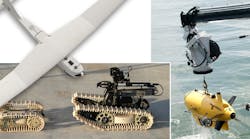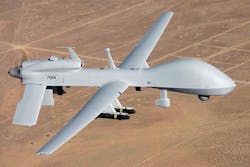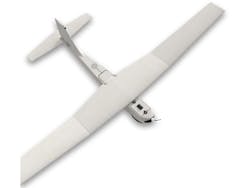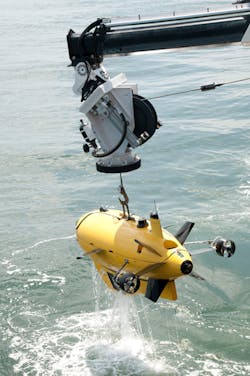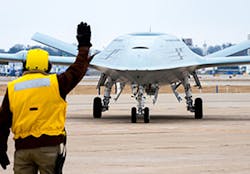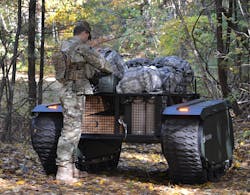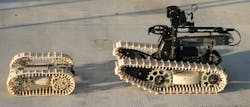Download this article in PDF format.
Machines no longer require the press of a button to start the power, especially for military missions. Autonomy is coming rapidly to robots and unmanned machines for military applications. They come in the forms of unmanned aerial vehicles (UAVs) and unmanned ground vehicles (UGVs) that can function without an operator, with the aid of artificial intelligence (AI) and environmental sensors. Significant investments by governments on behalf of military robotic applications are literally driving autonomous robotic technologies full speed ahead toward the vision of a battlefield where humans and machines team as partners.
Robots and unmanned vehicles, which have been part of the military landscape for some time, are increasingly used by all four branches of the U.S. military as well as by military forces around the world. Advances in electronic hardware and software support a trend of greater autonomy in these machines, making them more independent from the humans who create them. Military requirements for reduced size, weight, and power (SWaP) also make UAVs, UGVs, and ground robots smaller and lighter.
However, some of the more significant innovations are coming in the area of power, and finding ways, for example, to enable a drone to fly longer and gather more surveillance data without a recharge. The U.S. Department of Defense (DoD) categorizes UAV or UAS sizes into three groups, with the smallest vehicles in Group 1 and the largest called Group 3 vehicles.
UAVs: Predators, Pumas, Ravens, and More
Unmanned aircraft that are not fully autonomous may not have a pilot on board, but they rely on a human pilot for remote control. As an example, the Predator line of remotely piloted aircraft (RPA) from General Atomics Aeronautical Systems (GA-ASI) started with the RQ-1 Predator first flown in 1995 by the U.S. Air Force. One of the best-known military UAVs, it has evolved to the much more advanced Predator XP used by U.S. armed forces and licensed for use by allied armed forces around the world.
This latest version of the compact aircraft (Fig. 1) features an automatic takeoff and landing system (ATLS) so that the RPA can be launched and recovered without an operator in proximity. With its high-speed line-of-sight (LOS) and non-line-of-sight (NLOS) communication links, it can transfer data quickly from electro-optical (EO) and infrared (IR) cameras as well as many other sensors onboard the aircraft.
1. The Predator XP is one of the better-known military UAVs, adding functionality over time as it evolves with technology. (Courtesy of General Atomics Aeronautical Systems)
The Predator XP has 35-h flight endurance and can ascend to 25,000 ft. In addition, it incorporates a Lynx synthetic-aperture radar (SAR) for wide-area scanning under all weather conditions. Also onboard is a ground moving target indicator (MTI) for locating moving ground vehicles (including UGVs) and a maritime wide-area search (MWAS) mode for coastal surveillance and other maritime missions. The Predator XP flies with an automatic identification system (AIS) for identifying maritime vehicles. The company also makes the Raven, among the smallest of UAVs used by U.S. armed forces.
As UAVs are built smaller, they maintain the sensor capabilities of larger aircraft, including multiple cameras and radar systems. They often serve as robotic companions for surveillance and reconnaissance operations, keeping human warriors from dangerous situations. Among these smaller UAVs, the Puma 3 All Environment (AE) aircraft from AeroVironment is designed for hand or (as an optional) rail launching and manual or autonomous landing (Fig. 2). It has a 4.6-ft. (1.4-m) length and a 9.2-ft. (2.8-m) wingspan and weighs only 15 lb. (6.8 kg).
2. The Puma 3 AE is a compact UAV small enough to launch by hand. (Courtesy of AeroVironment)
Generally, designing these robotic systems according to SWaP requirements helps save power. In this case, the miniature UAV uses power efficiently but trades some flight time to work with a relatively small battery pack. With a rechargeable lithium-based battery pack, the Puma 3 AE has a maximum flight time of 2.5 h and can reach altitudes of 300 to 500 ft. The UAV’s wireless communications range is 20 km when operating with its standard antenna and as much as 60 km with an optional long-range tactical antenna (LRTA).
The company recently received a fixed-price contract exceeding $5 million for Puma 3 AE systems and support equipment for U.S. Border Patrol, to assist U.S. border patrol agents with remote surveillance. The award was made on behalf of the U.S. Border Patrol, part of the U.S. Customs and Border Protection. Use of the small UAV represents a much more cost-effective solution with greater area coverage than the same size contract for fewer, larger vehicles.
The RQ-11B Raven from AeroVironment is one of the U.S. Army’s most widely used UAVs. The hand-launched vehicle is a mere 3 ft. long with a 4.5 ft. wingspan. With a weight of only 4.2 lbs., its payload includes EO and IR cameras with an IR illuminator for night missions. It has flight times of 60 to 90 min. using rechargeable batteries and can transmit images to an operator at LOS distances as far as 10 km for reliable surveillance missions. It can be operated manually or autonomously, with on-board GPS guidance. The RQ-11B flies at altitudes of 100 to 500 ft.
Long-time supplier of unmanned aerial systems (UAS) Lockheed Martin Corp. provides both large and small unmanned systems, from large Warrior, Pioneer, Shadow, Eagle Eye, and Scout systems to smaller UAS vehicles like the Stalker eXtended Endurance (XE), which is launchable by rail or bungee. The Stalker can be powered by a solid oxide fuel cell or rechargeable battery for flight times of 8 h or more. The UAV only weighs 24 lb. but can carry payloads as large as 5.5 lb. Even with a relatively short 12-ft. wingspan, this UAS achieves altitudes to 12,000 ft.
The firm also developed an autonomous underwater vehicle (AUV)—the Marlin—for civilian and military applications (Fig. 3). With underwater control capability to 1000 ft. below the surface, the AUV is designed to inspect subsurface structures without putting human divers at risk. It carries a payload capable of performing high-resolution underwater scans that can be transformed into three-dimensional (3D) models.
3. The Marlin is an autonomous underwater vehicle capable of performing inspections 1000 ft. beneath the surface of the water. (Courtesy of Lockheed Martin)
As part of an $805 million 2018 contract, Boeing is developing the MQ-25 UAV for the U.S. Navy (Fig. 4). Flown from an aircraft carrier, it provides in-flight refueling capability for manned aircraft. The company recently completed the first test flight of the UAV with the U.S. Navy; the MQ-25 completed an autonomous taxi and takeoff and flew a programmed route. The flight of this first test vehicle (T1) comes about two years before the Navy is expected to receive the first of four operational MQ-25s. The refueler will provide the capability to autonomously extend the range of combat strike fighter jets, such as the F-35C, the EA-18G Growler, and the F/A-18 Super Hornet.
4. The MQ-25 UAV is being developed for the U.S. Navy for autonomous in-air refueling missions. (Courtesy of The Boeing Co.)
On the Ground
UGVs were initially developed to help ground forces in transferring heavy equipment. Over time, they have evolved into more tactical vehicles, assisting on surveillance and in search-and-destroy missions for IEDs. The Titan UGV (Fig. 5), developed by QinetiQ North America and Milrem Robotics, is an innovative modular UGV that can handle multiple missions, such as rescue, transport, and reconnaissance, and can be readily reconfigured when added or different functionality is needed.
5. The Titan is a modular UGV that can be reconfigured as mission requirements change. (Courtesy of QinetiQ North America)
Based on Milrem’s tracked hybrid modular infantry system (THeMIS), the Titan is 79 in. long and 83 in. wide. It weighs 2000 lbs. and can carry a maximum payload of 1500 lbs. The vehicle operates in manned and unmanned modes and handles as many as eight cameras, including optical, thermal, and IR devices. The UGV is controlled by the QuinetiQ tactical robotic controller (TRC) and robotic application kit (RAK) for autonomous operation.
Even smaller, the Dragon Runner 10 (DR-10) can be carried to a mission site (Fig. 6). The UGV provides situational awareness of a site to a remote operator with an easy-to-use controller. Developed by QinetiQ North America, the durable robot weighs only 10 lbs. but includes day and night cameras and communications transceivers to enable operators to remain at a safe distance. It’s fully capable of delivering remote sensors and placing counter-IED charges and fits well into the U.S. Army’s interest in extended mapping of tunnels.
6. The Dragon Runner 10 (DR-10) is a UGV light enough (10 lbs.) to be carried in a backpack. (Courtesy of QinetiQ North America)
The DR-10 ground robot is typical of the UGV designs being pursued by the U.S. Army Combat Capabilities Development Command's Army Research Laboratory (ARL) and partners such as NASA’s Jet Propulsion Laboratory (JPL) and Carnegie Mellon University. The ARL's Robotics Collaborative Technology Alliance (RCTA) is involved in developing autonomous methods that support manned and unmanned ground robots and research for the development of future combat ground vehicles. As part of the 2019 Army Modernization Strategy (AMS), near-term goals include neutralizing IEDs by means of a remote armament system (RAS), a defensive approach that can be applied in open battlefields as well as urban areas.
The U.S. Marines have long valued the operating speed and flexibility of the Hunter wheeled offload logistics follower (WOLF) from HDT Global. Originally developed for explosive ordnance disposal, the Hunter WOLF combines a 1000-lb. payload with the dexterity of its Adroit robotic arms for precise handling of objects, such as IEDs. The 6 × 6 wheeled ground robot features an electric-hybrid power train (including internal fuel for an electric generator) with a running time of 96 h. It has a range of 100 miles (160 km) and can even ford water levels as high as 24 in.
As the trends indicate, military robotic systems are growing smaller and smarter, inviting slogans from some of the UAV/UGV suppliers about the partnerships of man and machine on the battlefield. These systems can make the battlefield safer for humans, but their values extend much further. Robotic systems are being used around the world for public safety, for fighting fires, even for delivering medicine to patients in remote areas. Robots are earning their places alongside humans and, with the increasing use of AI, will learn to do even more.
